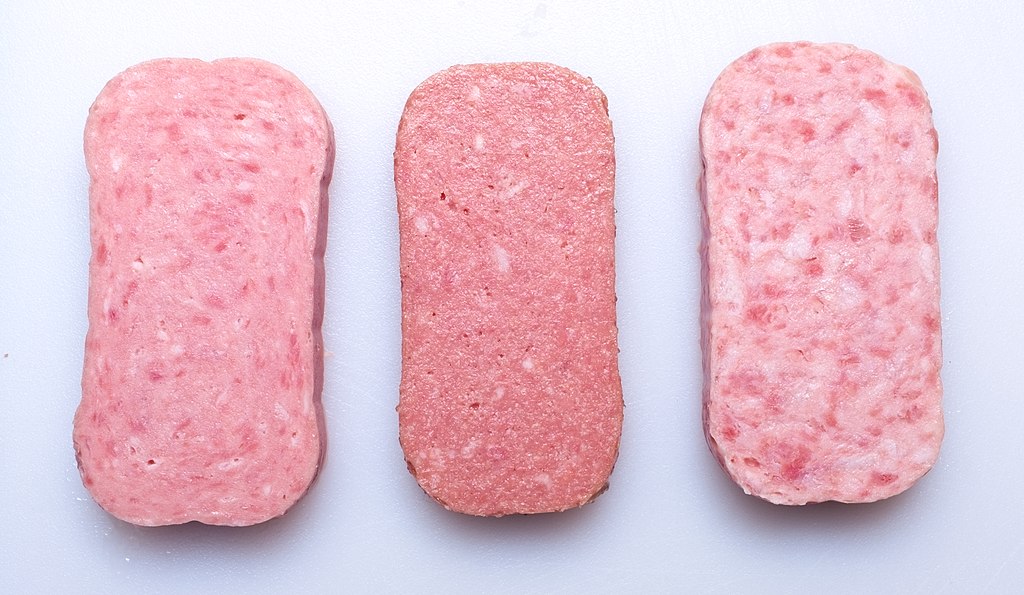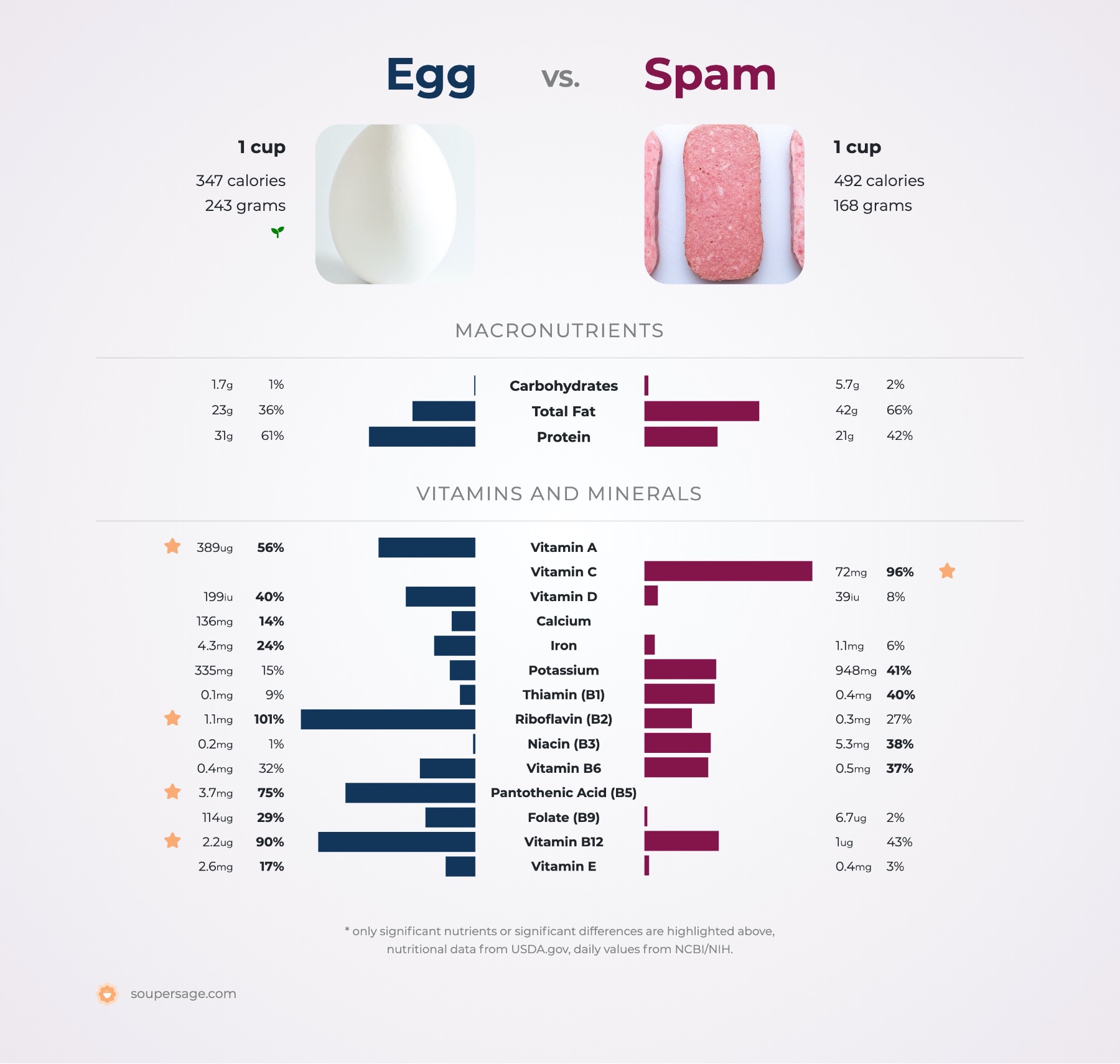Egg vs. Spam
Nutrition comparison of Egg and Spam
Ever wonder how your favorite foods stack up against each other in terms of nutrition?
We compared the nutritional contents of
egg
versus
spam
(100g each)
below using 2020 USDA and NIH data[1].
For a quick recap of significant nutrients and differences in egg and spam:
- Both egg and spam are high in calories and protein.
- Egg is a great source of Vitamin D and calcium.
- Egg is an excellent source of Vitamin A.
- Spam has more thiamin and niacin, however, egg contains more riboflavin, pantothenic acid and folate.
- Spam is an excellent source of Vitamin C and potassium.
USDA sources for nutritional information: Egg (Egg, whole, raw, fresh) and Spam (Luncheon meat, pork, ham, and chicken, minced, canned, reduced sodium, added ascorbic acid, includes SPAM, 25% less sodium) . Have a correction or suggestions? Shoot us an email.
Calories and Carbs
calories
Both egg and spam are high in calories. Spam has 105% more calories than egg - egg has 143 calories per 100 grams and spam has 293 calories.
For macronutrient ratios, egg is heavier in protein, lighter in fat and similar to spam for carbs. Egg has a macronutrient ratio of 36:2:62 and for spam, 17:5:78 for protein, carbohydrates and fat from calories.
Macro Ratios from Calories:
| Egg | Spam | |
|---|---|---|
| Protein | 36% | 17% |
| Carbohydrates | 2% | 5% |
| Fat | 62% | 78% |
| Alcohol | ~ | ~ |
carbohydrates
Both egg and spam are low in carbohydrates - egg has 0.72g of total carbs per 100 grams and spam has 3.4g of carbohydrates.
sugar
Egg and spam contain similar amounts of sugar - egg has 0.37g of sugar per 100 grams and spam does not contain significant amounts.
Protein
protein
Both egg and spam are high in protein. Egg is very similar to spam for protein - egg has 12.6g of protein per 100 grams and spam has 12.5g of protein.
Fat
saturated fat
Spam is high in saturated fat and egg has 65% less saturated fat than spam - egg has 3.1g of saturated fat per 100 grams and spam has 8.9g of saturated fat.
trans fat
Both egg and spam are low in trans fat - egg has 0.04g of trans fat per 100 grams and spam does not contain significant amounts.
cholesterol
Egg is high in cholesterol and spam has 80% less cholesterol than egg - egg has 372mg of cholesterol per 100 grams and spam has 76mg of cholesterol.
Vitamins
Vitamin C
Spam is an excellent source of Vitamin C and it has more Vitamin C than egg - spam has 43mg of Vitamin C per 100 grams and egg does not contain significant amounts.
Vitamin A
Egg is an excellent source of Vitamin A and it has more Vitamin A than spam - egg has 160ug of Vitamin A per 100 grams and spam does not contain significant amounts.
Vitamin D
Egg is a great source of Vitamin D and it has 257% more Vitamin D than spam - egg has 82iu of Vitamin D per 100 grams and spam has 23iu of Vitamin D.
Vitamin E
Egg and spam contain similar amounts of Vitamin E - egg has 1.1mg of Vitamin E per 100 grams and spam has 0.24mg of Vitamin E.
Vitamin K
Egg and spam contain similar amounts of Vitamin K - egg has 0.3ug of Vitamin K per 100 grams and spam does not contain significant amounts.
The B Vitamins
Spam has more thiamin and niacin, however, egg contains more riboflavin, pantothenic acid and folate. Both egg and spam contain significant amounts of Vitamin B6 and Vitamin B12.
| Egg | Spam | |
|---|---|---|
| Thiamin | 0.04 MG | 0.264 MG |
| Riboflavin | 0.457 MG | 0.179 MG |
| Niacin | 0.075 MG | 3.175 MG |
| Pantothenic acid | 1.533 MG | ~ |
| Vitamin B6 | 0.17 MG | 0.283 MG |
| Folate | 47 UG | 4 UG |
| Vitamin B12 | 0.89 UG | 0.61 UG |
Minerals
calcium
Egg is a great source of calcium and it has more calcium than spam - egg has 56mg of calcium per 100 grams and spam does not contain significant amounts.
iron
Egg has 173% more iron than spam - egg has 1.8mg of iron per 100 grams and spam has 0.64mg of iron.
potassium
Spam is an excellent source of potassium and it has 309% more potassium than egg - egg has 138mg of potassium per 100 grams and spam has 564mg of potassium.
Omega-3 and Omega-6
omega 3s
For omega-3 fatty acids, spam has more alpha linoleic acid (ALA) than egg per 100 grams, however, egg contains more dha than spam per 100 grams.
| Egg | Spam | |
|---|---|---|
| alpha linoleic acid | 0.048 G | 0.23 G |
| DHA | 0.058 G | ~ |
| DPA | 0.007 G | ~ |
| Total | 0.113 G | 0.23 G |
omega 6s
Comparing omega-6 fatty acids, both egg and spam contain significant amounts of linoleic acid.
| Egg | Spam | |
|---|---|---|
| other omega 6 | 0.022 G | ~ |
| linoleic acid | 1.555 G | 2.436 G |
| Total | 1.577 G | 2.436 G |
Customize your serving size
The comparison below is by common portions, e.g. cups, packages. You can also see a more concrete comparison by weight at equal weight (by grams) comparison.
Egg g
()
|
Daily Values (%) |
Spam g
()
|
|||||
|---|---|---|---|---|---|---|---|
| KCAL % |
|
5% | calories | 5% |
|
KCAL % | |
| G % |
|
5% | carbohydrates | 5% |
|
G % | |
| G % |
|
5% | dietary fiber | 5% |
|
G % | |
| G | 5% | sugar | 5% | G | |||
| G % |
|
5% | total fat | 5% |
|
G % | |
| G % |
|
5% | saturated fat | 5% |
|
G % | |
| G | 5% | monounsaturated fat | 5% | G | |||
| G | 5% | polyunsaturated fat | 5% | G | |||
| G | 5% | trans fat | 5% | G | |||
| MG | 5% | cholesterol | 5% | MG | |||
| MG % |
|
5% | sodium | 5% |
|
MG % | |
| 5% | Vitamins and Minerals | 5% | |||||
| UG % |
|
5% | Vitamin A | 5% |
|
UG % | |
| MG % |
|
5% | Vitamin C | 5% |
|
MG % | |
| IU % |
|
5% | Vitamin D | 5% |
|
IU % | |
| MG % |
|
5% | calcium | 5% |
|
MG % | |
| MG % |
|
5% | iron | 5% |
|
MG % | |
| MG % |
|
5% | magnesium | 5% |
|
MG % | |
| MG % |
|
5% | potassium | 5% |
|
MG % | |
| MG % |
|
5% | thiamin (Vit B1) | 5% |
|
MG % | |
| MG % |
|
5% | riboflavin (Vit B2) | 5% |
|
MG % | |
| MG % |
|
5% | niacin (Vit B3) | 5% |
|
MG % | |
| MG % |
|
5% | Vitamin B6 | 5% |
|
MG % | |
| MG % |
|
5% | pantothenic acid (Vit B5) | 5% |
|
MG % | |
| UG % |
|
5% | folate (Vit B9) | 5% |
|
UG % | |
| UG % |
|
5% | Vitamin B12 | 5% |
|
UG % | |
| MG % |
|
5% | Vitamin E | 5% |
|
MG % | |
| UG % |
|
5% | Vitamin K | 5% |
|
UG % | |
| G % |
|
5% | protein | 5% |
|
G % | |
| UG % |
|
5% | biotin (Vit B7) | 5% |
|
UG % | |
| MG % |
|
5% | choline | 5% |
|
MG % | |
| MG % |
|
5% | chlorine | 5% |
|
MG % | |
| UG % |
|
5% | chromium | 5% |
|
UG % | |
| MG % |
|
5% | copper | 5% |
|
MG % | |
| UG % |
|
5% | fluoride | 5% |
|
UG % | |
| UG % |
|
5% | iodine | 5% |
|
UG % | |
| MG % |
|
5% | manganese | 5% |
|
MG % | |
| UG % |
|
5% | molybdenum | 5% |
|
UG % | |
| MG % |
|
5% | phosphorus | 5% |
|
MG % | |
| UG % |
|
5% | selenium | 5% |
|
UG % | |
| MG % |
|
5% | zinc | 5% |
|
MG % | |
| G | 5% | Water | 5% | G | |||
| G | 5% | Starch | 5% | G | |||
| G | 5% | Alcohol | 5% | G | |||
FAQ
Does egg or spam contain more calories in 100 grams?Both egg and spam are high in calories. Spam has 110% more calories than egg - egg has 143 calories in 100g and spam has 293 calories.
Is egg or spam better for protein?
Both egg and spam are high in protein. Egg is very similar to spam for protein - egg has 12.6g of protein per 100 grams and spam has 12.5g of protein.
Does egg or spam contain more potassium?
Spam is a rich source of potassium and it has 310% more potassium than egg - egg has 138mg of potassium in 100 grams and spam has 564mg of potassium.


